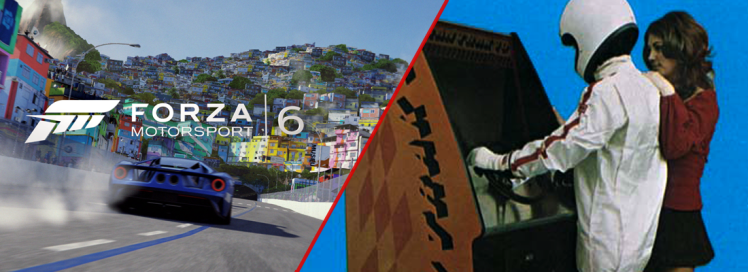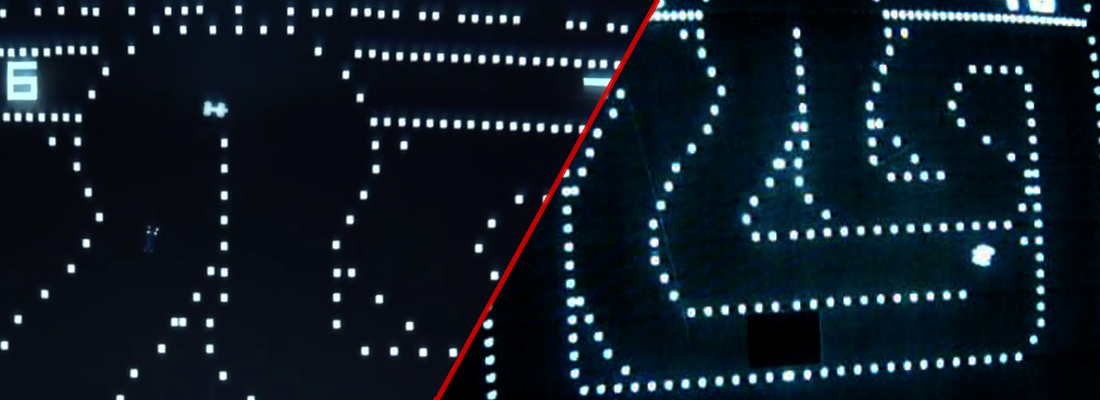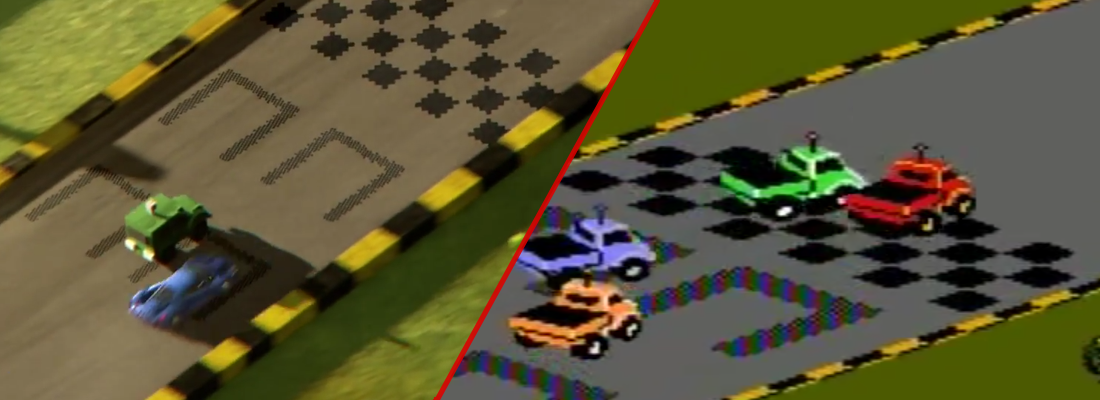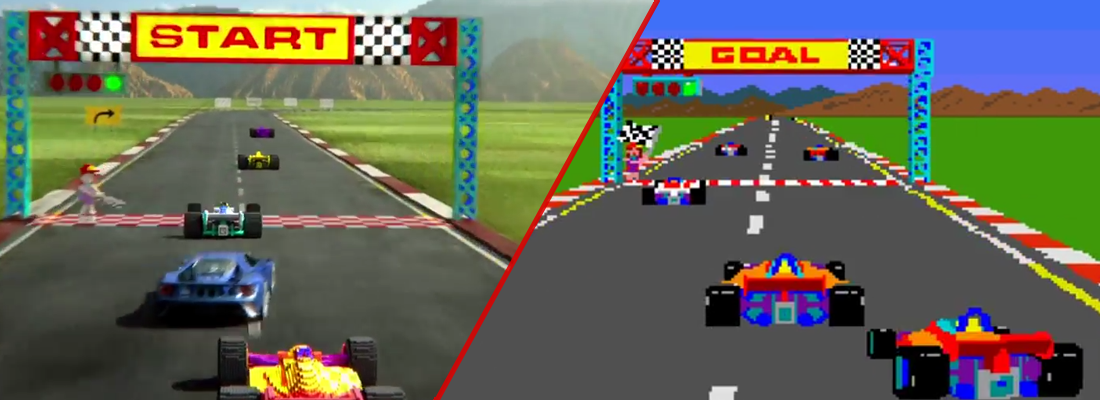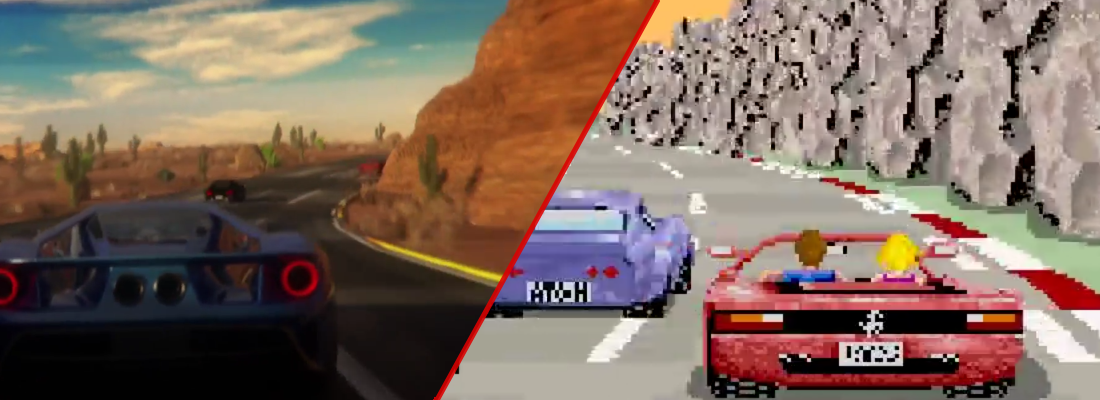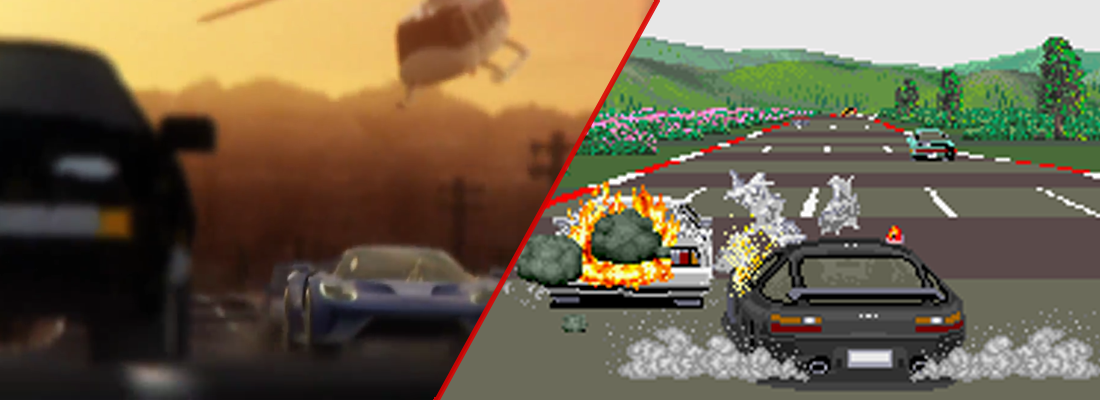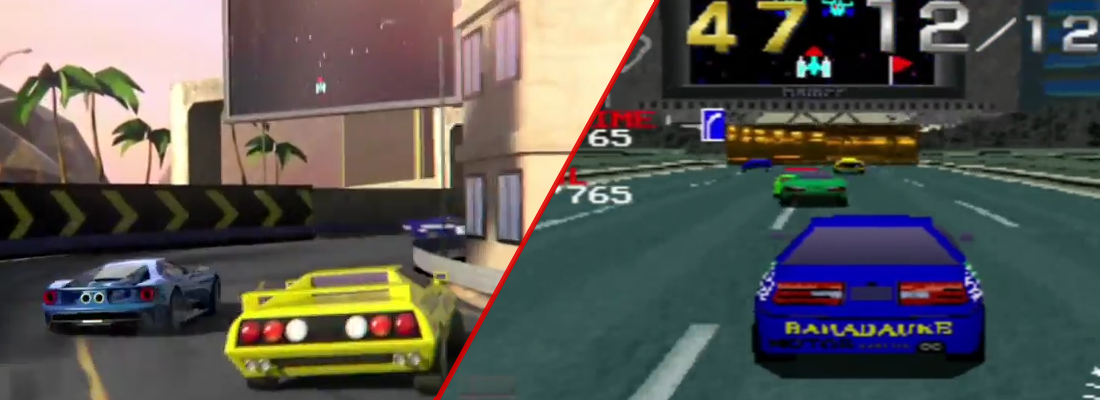Earlier this week, I was talking about the Forza Motorsport 6 retro TV ad that Turn 10 Studios released, and how it was a surprisingly humble — for the game industry — way of paying homage to the driving and racing genre.
While I am more than old enough to catch every major reference in the commercial, some of you may not be as ancient as I. For those of you curious about which game is which in the ad, and you’d like a starting point for researching more about them, I’m here to help.
I also resent your youth and vigor. Let’s begin!
Gran Trak 10
Developer: Atari Games
Publisher: Atari Games
Year: 1974
Platform: Arcade
Say hello to one of the grandfathers of the racing games.
Gran Trak 10 is a charmingly visceral arcade experience from video games’ primordial period. It features the antiquated tech of the groovy ’70s, including a black-and-white CRT monitor that displays a race track from a top-down view. White blocks act as pylons, which form the outside barrier of the course.
A special transparent film lays directly on top of the monitor tube, displaying a gray oil slick patch and orange-ish checkpoint lines. This feature is not totally cosmetic. The onscreen car will react and lose control when driving over the oil slick portion of the road.
What blows me away about Gran Trak 10, however, is its complexity for the time. The cabinet features the obligatory gas, brake pedal, and four gear manual shifter, which you must use skillfully. A player can’t just put their foot to the floor and spin the wheel to victory. Turns require intelligent down-shifting, speed adjustment, and line-plotting in order to traverse the course without crashing.
If the game mechanics of Gran Trak 10 doesn’t sound impressive, keep in mind that this is an era where Breakout and Pong were considered cutting edge video games (*Steve Wozniak, designer of Breakout, reportedly played Gran Trak 10 feverishly throughout Breakout’s four-day development cycle).
R.C. Pro-Am
Developer: Rare
Publisher: Nintendo
Year: 1987
Platform: Nintendo Entertainment System
Before Battletoads, Donkey Kong Country, and GoldenEye 007, the game that launched legendary development house, Rare, into popularity was a little Nintendo racer called R.C. Pro Am.
Contextually, this is a strange addition to the commercial. R.C. Pro Am, as the name points out, is a game about driving remote-controlled cars. Although at the time, no one noticed the difference considering the entire “radio controlled” portion of the game was practically non-existent.
The big selling point of R.C. Pro Am is that it ditched the one-point perspective that Rad Racer, Pole Position, and OutRun were attempting to perfect. Rare decided to instead go with a psuedo-three quarters top-down view of the track. This swap in angles allowed the play mechanics to lay emphasis on wildly sensitive turning skills that felt satisfyingly slippery, something the one-point perspective wouldn’t be able to nail until the rise of the 3D game engine.
Pole Position
Developer: Namco
Publisher: Atari Games (North America), Namco (Japan)
Year: 1982
Platform: Arcade
Only one sound bite is required to transport an entire generation of players back to a ’80s arcade: “Prepare to qualify”
Pole Position wasn’t the first of the one-point perspective driving games (for that chunk of trivia, you’re looking for at least Night Driver or Nürburgring 1), but it was one of the most influential. Players took control of an 8-bit Formula 1 car that screamed into the electronic horizon. No matter what place you took in the starting grid, you’ll always an unending onslaught of slower vehicles to swerve around.
Although the first game only featured one track with a handful of turns, those corners require an arcade gamer’s twitch to navigate and maximize both speed and score. Luckily, shifting isn’t complicated, as there are only two gears: High and Low.
Even with that control simplicity, there is absolutely no room for error in Pole Position, especially when it comes to making contact with other cars. The slightest tap between vehicles would detonate both autos into a pixelated cloud of fire and car parts. At times, Pole Position was less a driving game and more a simulation to see how cars driving with nitroglycerin filled tires would react.
The original arcade game is still a fun and challenging experience, if you can find it. Although Pole Position had a huge run, with thousands of cabinets produced, the control boards that run the game are notorious for being a pain to keep running. So if you see one on location that works, don’t waste the opportunity and play the thing … before it inevitably dies.
Outrun
Developer: Sega AM2
Publisher: Sega
Year: 1986
Platform: Arcade
In the ’80s Yu Suzuki (Space Harrier, Virtua Fighter, Shen Mue) was obsessed over three things: finding a way to hook players within three minutes of play time, faking the visual excitement of oncoming speed using 2D sprites, and Ferrari.
OutRun is the culmination of these ideals.
Although OutRun shares some similarities with Pole Position, in that they are both one-point perspective racing games, OutRun is a bit less harsh on the driver. Turns still need to be navigated at high speeds with smart shifting and turning, but the play isn’t nearly as challenging when it comes to keeping the car on the track. Bumping into other vehicles also didn’t mean dying in an instant pixelated mushroom cloud. It just pissed off the blonde chick sitting in the passenger seat.
Cosmetically, OutRun is a 16-bit version of a Yu Suzuki daydream. Suzuki paints an interactive picture where he’s driving a Ferrari, extremely fast, up the American West Coast, before darting horizontally across the map through a wild caricature of the country’s many locations, before finally skidding to a finish in the East Coast. It’s a high speed trip across America completed in one day, with a breezy soundtrack blasting through the stereo, and a blonde in the passenger seat.
Chase H.Q.
Developer: Taito
Publisher: Taito
Year: 1988
Platform: Arcade
Chase H.Q. is a unique entry in this ad, since the game isn’t necessarily about racing as much as chasing. Players take the role of two special criminal investigation detectives, who are complete rip offs of Crocket and Tubbs from Miami Vice. These ’80s G-men serve justice against Reagan-era boogeymen — serial killers, drug dealers, and Eastern Block commies — by ramming their cars off the highway with their black 1982 Porsche 928.
The mechanics weren’t so much concerned with mastering a track. In fact, it was pretty difficult to drive the car off the road on purpose. The real challenge was dodging civilian traffic at high speed while catching up to the target vehicle. Once the criminal’s car was within bumping distance, simply hit the sirens and get to … well … grinding their rear end into submission.
The cabinet features red and blue flashers, so when the siren was active in-game, everyone in the arcade knew you were ramming justice into the backs of 16-bit criminals.
Ridge Racer
Developer: Namco
Publisher: Namco
Year: 1994
Platform: PlayStation
Although it’s not the first polygonal racing game (Hello, Virtua Racing), the PlayStation port of the first Ridge Racer (arcade version in 1993) was the entry point for a lot of people into the world of 3D driving.
This new world made the one-point perspective techniques obsolete, as the engine no longer had to fake sprites flying towards the player via scaling, and tracks could be built in a more intuitive way.
The big play mechanic that Ridge Racer brought to the genre was drifting. If the player took the bend just the right way, the car would begin to slide sideways and around the arch of the turn. Drift has pros and cons. Although sliding around the turn seems like an easier and cooler way to navigate, you could lose time and control of the momentum of the car.
In either case, drifting has become a default mechanic in today’s driving games, mostly thanks to Ridge Racer’s influence.
VentureBeat's mission is to be a digital town square for technical decision-makers to gain knowledge about transformative enterprise technology and transact. Learn More
